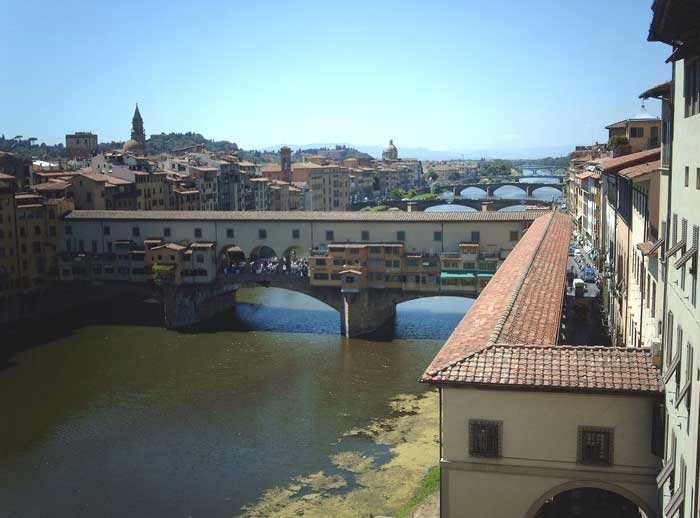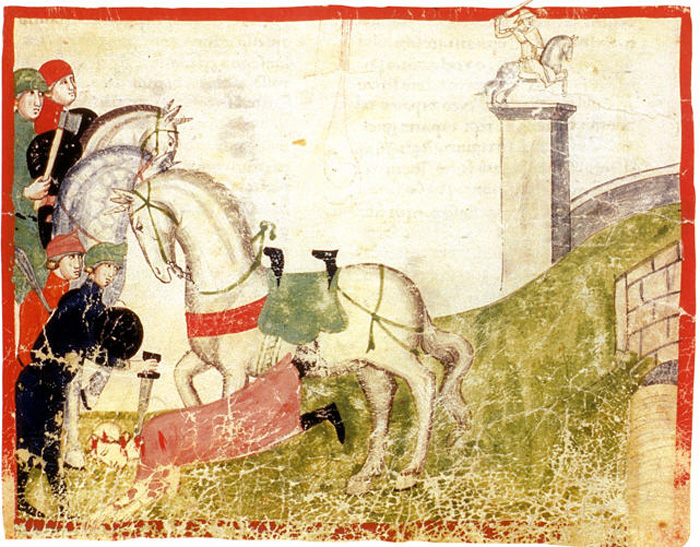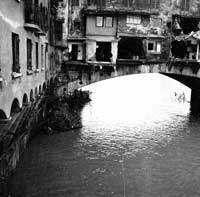| |
|
| |
|
|
|
|
|
|
| |
 |
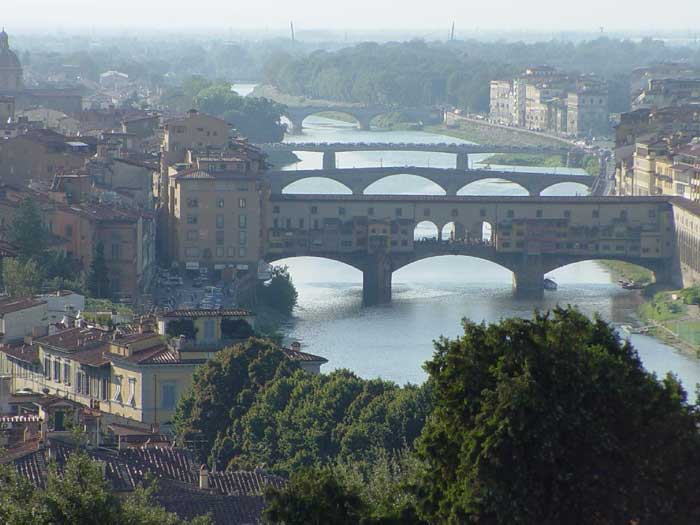 |
| |
Ponte Vecchio, view from Piazza Michelangelo. Piazzale Michelangelo is a famous square with a magnificent panoramic view of Florence
|
|
 |
 |
| |
|
|
|
| |
|
Tuscany Travel Guide | Art in Florence | The Ponte Vecchio
|
|
|
|
| |
|
| The most famous and oldest bridge in Florence is the Ponte Vecchio, which already existed in Roman times and which was replaced by a new bridge in 1345. Towards the end of the 16th century, Duke Ferdinand I decreed that the goldsmiths should use the shops along both sides of it.
|
|
|
|
| |
|
|
|
|
|
The evolution of the bridge is accompanied by that of the Corridoio Vasariano (1554), which connects the Uffizi palace with the Palazzo Pitti and was supported in the middle of the bridge by three arcades. At the Borgo San Jacopo end of the bridge, Vasari was forced to construct supports to take the corridor round the Mannelli tower because the owners refused to let the corridor pass through it. The medieval Ponte Santa Trinita collapsed in 1557 during a flood. The reconstruction by Bartolomeo Ammannati between 1567 and 1570 is a prime example of building excellence. Three majestic bridge piers support the flat, elliptic curves of the arches. Kriegbaum linked the “dynamic fantasy of architecture” to a section of a letter, according to which there had been a design by Michelangelo. This Roman design had come to Florence and been taken into account by Ammannati. In 1608, four statues portraying the allegories of the four seasons were erected on the occasion of the wedding of Cosimo II to Maria Magdalena of Austria.
|
|

Torre dei Mannelli |
|
|
The Vasari Corridor and Ponte Vecchio
|
|
|
|
|
|
|
|
View from the Ponte Vecchio, Ponte Santa Trinita and the chiesa di San Frediano in Cestello [6]
|
|
|
|
The Amidei family and the Torre degli Amidei
|
The Amidei were a prominent family in Florence and Tuscany. They owned lands and a castle in Mugnana. The family business began as production of olive oil and wine, and had developed into banking. In fact there was one or more wills in which the father stated he was leaving some credits that had to be withdrawn. In 1182, Bongianni of the Amidei was a Florentine councillor. In the early thirteenth century, the Amidei were allied with the Ghibelline faction, led by the Uberti and Lamberti families. Their strongold was on via Por San Maria, which connected the Ponte Vecchio to the Mercato Nuovo and Mercato Vecchio. The remains of their tower, Torre degli Amidei, still be seen.
The Amidei are best remembered for a particular event during the Guelf and Ghibelline conflicts. In 1215, during a banquet celebrating the ennoblement of a young Florentine, one of the guests, Buondelmonte de' Buondelmonti, stabbed a rival in the arm. In restitution for the injury and dishonor, the elders decided that young Buondelmonte should wed a girl from the Amidei. That arranged, the Amidei and Buondelmonti families arranged a engagement ceremony, where Buondelmonte was to publicly pledge troth to the Amidei girl. With the Amidei assembled in the piazza, the young Buondelmonte man rode past the Amidei, and instead asked for the hand of a girl from the Donati family, members of the Guelf faction.
Furious, the Amidei and allies plotted revenge. They debated whether they should scar Buondelmonte's face, beat him up, or kill him. Mosca di Lamberti took the floor and argued that they should kill him at the place where he had dishonoured them. His famous words, 'cosa fatta capo ha', were recorded in Dante's Inferno and an earlier chronicle known as Pseudo-Latini. On Easter morning on his way to marry the Donati girl, as Buondelmonte crossed the Ponte Vecchio, he was waylaid by the Amidei and their allies, and murdered. The Buondelmonte murder and its associated clan rivalry became the legendary origin of the Guelf and Ghibelline conflict in Florence, but early 14th century chroniclers, including Dino Compagni and Giovanni Villani, manipulated the story to lay blame for the conflict on one group or another.[4]
|
The Torre degli Amidei is a tower in Florence, Italy. Dating from the upper Middle Ages, it is located near the Piazza della Signoria. Once located near the city's ancient walls, it belonged to the Amidei family, and, according to the tradition, was the alleged location of the killing of Buondelmonte de' Buondelmonti by one Amidei.
In 1944 it was damaged by the retreating German Army, and was later partially rebuilt. Its current appearance and decoration (including the double, superimposed arches of the entrances) dates also from 19th century restorations. Above the doors are two lion heads, one of which is original and is perhaps from Etruscan times. [3]
Address: Torre degli Amidei (Via Por Santa Maria/Borgo SS. Apostoli nr. 9/r)
|
|
The Buondelmonte murder, from an illustrated manuscript of Giovanni Villani's Nuova Cronica
in the Vatican Library (ms. Chigiano L VIII 296 - Biblioteca Vaticana)
|
The Church of San Jacopo Soprarno
|
|
|
The Chiesa di San Jacopo Soprarno shows elements from different periods and styles - from Romanesque to Baroque. The San Jacopo in Soprarno was built in Romanesque style, but experienced heavy modifications, including the addition of a triple-arched portico. The Romanesque church with three naves goes back to 12th Century, but was restructured many times and its original form has been deeply alterated: the façade is characterized by an arcade dating from the same time of the original church, although it was added in 1580 and comes from the Church of San Donato in Scopeto, demolished in 1529 during the construction of fortifications. The entrance portico was remade by order of Cosimo I de' Medici in 1580. The bell-tower we see today was built in 1660 by Gherardo Silvani.
The interior was modified in the 18th Century, when the Ridolfi Chapel was demolished with its dome built by Brunelleschi (perhaps it was a scaled-down demonstrative example of the famous Dome of the Cathedral, as Vasari says).
On the façade are notable columns and the architrave with its particular decoration with animal heads.
The church has eleven side chapels and is enriched by gilded stuccos; the frescoes on the vault are a work of Vincenzo Meucci, those in the presbytery (Glory of San Jacopo) and behind the main altar were painted by Matteo Bonechi. At the side altars, Paintings by various Florentine artists from 17th-18th Century.
The church was damaged when the Arno River flooded Florence in 1966. Repairs of the church after flood led to the restoration of some of the historical architectural features[1], and the discover of columns belonging to the original Romanesque church in the Baroque interior.
On November 4, 1966, Florence experienced the most devastating flood of its entire history, which crippled the city and destroyed many of the world's art treasures. On
the south side, in the Oltrarno, waters rushed past San Jacopo Sopr'Arno, Palazzo Guicciardini, the Palazzo Pitti, Santo Spirito and Borgo San Frediano.The Arno River overflowed its banks and flooded the city of Florence. The flood killed many people and damaged or destroyed millions of masterpieces of art and rare books in Florence. Millions of books and pieces of art were damaged by the water and mud, including a third of the collection of the Biblioteca Nazionale.
|
|
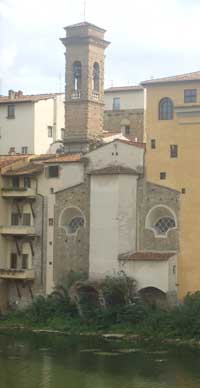
Chiesa di San Jacopo Soprarno |
|
|
|
|
|
| |
|

Florence | The Ponte Vecchio and the Buondelmonte murder
|
|
|
 |
| |

[1] Hilde Lotz-Bauer’s photographs are significant because the bridge was completely destroyed during the Second World War and reconstructed after the war. The photographer Hilde Lotz-Bauermet art historian Wolfgang Lotz (1912-1981) at the Kunsthistorisches Institut in Florence in 1939, and married him in 1941 in what would be her second marriage. The then director of the Institute, Friedrich Kriegbaum, commissioned Lotz-Bauer to complete a range of photographic projects, which were, however, abandoned after his death during an air raid on Florence in 1943.
The online exhibition focuses on photographs by Hilde Lotz-Bauer which were commissioned by Friedrich Kriegbaum, the then director of the Kunsthistorisches Institut in Florenz. Her close-ups of works by Michelangelo, Benvenuto Cellini and Giambologna trace the development and history of scientific photography and remain a significant legacy. Her penchant for unusual perspectives is illustrated by her panoramic and close-up views, taken with her plate camera directly on the rooftops, of the ancient part of Florence before it was destroyed during the air raids. A selection of these photographs was displayed in the Palazzo Strozzi in Florence in 1977 on the occasion of Lotz-Bauer's seventieth birthday, in an exhibition entitled "Chiese, palazzi e ponti fotografati con bravura". Lotz-Bauer's photographs of Roman squares and fountains were taken between 1935 and 1938 and have been kindly placed at the Institute's disposal by Franz Schlechter, who owns the majority of Hilde Lotz-Bauer's photographic inheritance.
Kunsthistorisches Institut in Florenz | Bridges
Address: Kunsthistorisches Institut in Florenz – Max-Planck-Institut, Via Giuseppe Giusti 44, 50121 Firenze.
|
[2] On November 4, 1966 the Arno River, already a swollen stream at that
time, literally invaded Florence and left in its wake a tale of violent destruction as well as one of profound sadness.
Florence had become an immense lake of water, mud and fuel oil covering, according to one estimate, more than seven thousand acres. The bridges connecting the two sides were impassable, turning Florence into two cities. Plaques that recorded the height of previous floods were quickly covered with water and oil. In the Piazza Santa Croce, the water reached more than twenty-two feet, more than twice as high as the flood of 1557.
The greatest loss was the Crucifixion by Giovanni Cimabue, the Father of Florentine Painting, in the Santa Croce Museum. The water there rose thirteen feet and the painting was ruined.
At the National Library, the flood damaged 1,300,000 items, including the majority of the works in the Palatine and Magiabechi collections, along with periodicals, newspapers, prints, maps and posters. This was a third of the library's collections.
There was also extensive damage to the collections at the Opera del Duomo, the Gabinetto Vieusseux Library and the State Archives.
|
|
|
[3] Grimaldi, Fortunato (2005). Le "case-torri" di Firenze. Florence: Edizioni Tassinari
[4] Giovanni Villani, Nuova Cronica, ed. G. Porta. 6.38.
In the words of Dante, “Conveniasi a qvella pietra scema che gvarda il ponte che fiorenza fesse vittima nella sva pace postrema.” Peace has ended in Florence. It was a cold February day in 1216 when Buondelmonte de’ Buondelmonti was viciously murdered by Schiatta Uberti and Oddo Arrighi. This resulted a feud that would continue on between the families until well into the fourteenth century. This feud would change Florence completely and it would never return to what it once was.
Giovanni Villani was an I talian chronicler whose European attitude to history foreshadowed Humanism. The history of Florence may be said to have commenced with two writers, Dino Compagni and Giovanni Villani, both born in the second half of the thirteenth century.
Villani was a merchant by profession, and, like Dante and so many others, he went to Rome in the year 1300, at the time of the indulgence which had been decreed by Boniface VIII. He was so impressed by what he saw that he determined to write a book about his native city Firenze, the Nuova Cronica (new chronicle).
[5] Foto da Björn S..., publicato sotto la licenza Creative Commons Attribuzione-Condividi allo stesso modo 2.0 Generico
|
|

Bust of Benvenuto Cellini, by Raffaello Romanelli (1901), at the centre of the Ponte Vecchio, Firenze, Italy. Photo by Thermos.
|
|
This article incorporates material from the Wikipedia articles Ponte Vecchio, Amidei, published under the GNU Free Documentation License.
Wikimedia Commons has media related to Ponte Vecchio.
|
| |
|
|

Tuscan Holiday houses | Podere Santa Pia
|
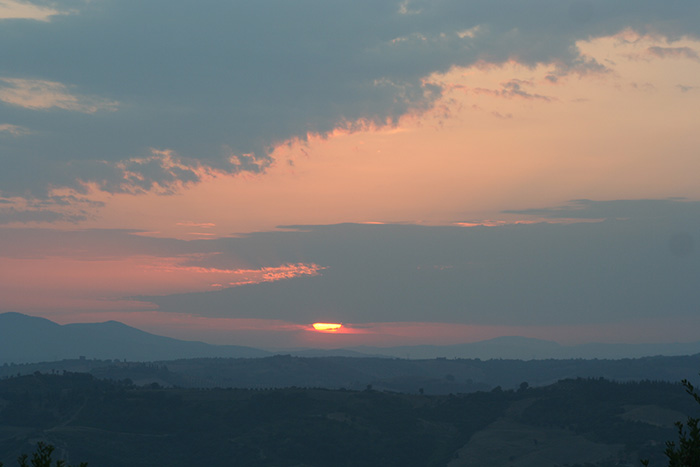 |
Podere Santa Pia, the view from the main terrace is definitely spectacular
|
| |
|
|
|
|
|
|
|
|
|
|
Podere Santa Pia |
|
Podere Santa Pia, garden |
|
Florence, Duomo
|
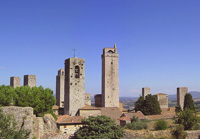 |
|
 |
|
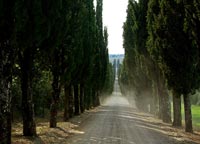 |
| The towers of San Gimignano |
|
Sant'Antimo, between Santa Pia and Montalcino |
|
Villa Arceno gardens |
| |
|
|
|
|
| |
|
|
|
|
| |
|
|
Strolling in Firenze | A walk from Ponte Vecchio to Piazzale Michelangelo
|
|
 |
 |
|
| |
|
| 1 | A Walk Around the Uffizi Gallery
2 | Quarter Duomo and Signoria Square
3 | Around Piazza della Repubblica
4 | Santa Maria Novella
5 | San Niccolo Neighbourhood in Oltrarno
6 | Walking in the Bargello Neighbourhood
7 | From Fiesole to Settignano
|
|
 |
|
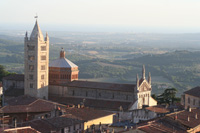 |
|
 |
Sant'Antimo, between Santa Pia and Montalcino |
|
Massa Marittima |
|
The towers of San Gimignano |
| |
|
|
|
|
| |
|
|
|
|
| |
|
|
|
| |
|
|
|
| |
|
|
|
| |
|
|
|
| |
|
|
|
| |
|
|
|
![]()
![]()
![]()
![]()
![]()




